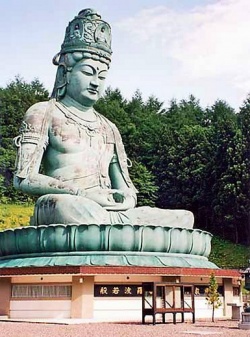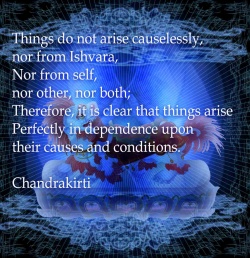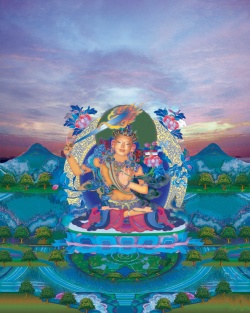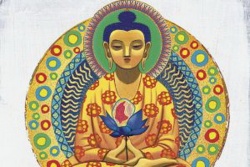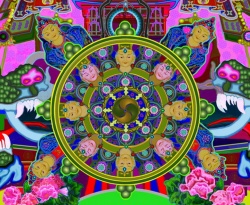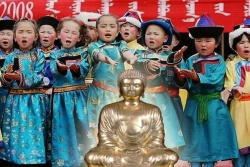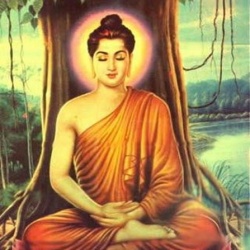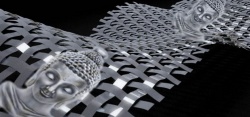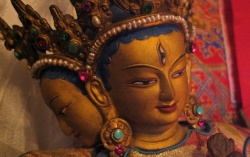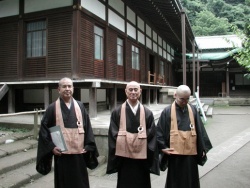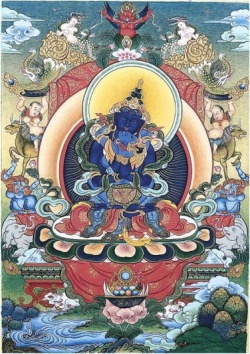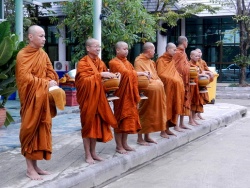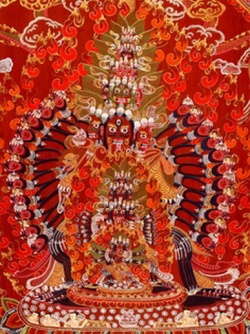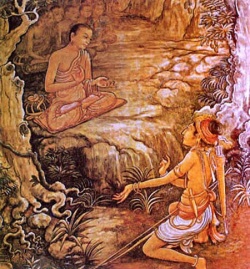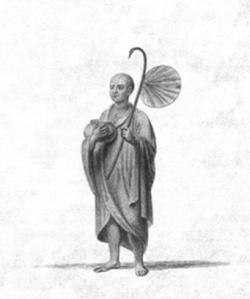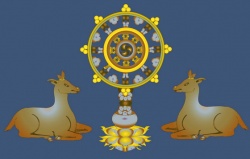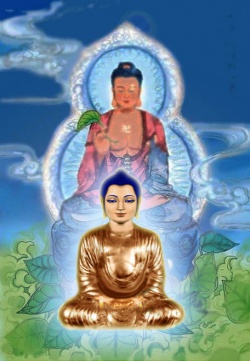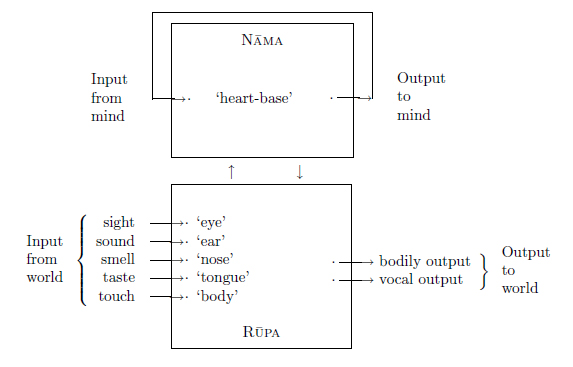The Abhidhamma Model of Consciousness and some of its Consequences
The Abhidhamma Model of Consciousness
and some of its Consequences
Henk Barendregt hhenk@cs:ru:nli
Radboud University Nijmegen
The Netherlands
Abstract
An important canonical Theravada[1] Buddhist text is the Abhidhamma, one of three sets of volumes known collectively as the Tipitaka[2]. It is written around 250 BC in Pali, an ancient language related to Sanskrit. The Abhidhamma, covering more than 8000 pages, deals with phenomenological psychology, obtained as side effect of meditation used as trained introspection. It describes an intricate model of consciousness on three levels.The first level consists of a discrete, serial stream of `atoms of awareness' called cetas. Secondly, a linear sequence of cetas may form a `molecule', called vīthi, being a cognitive-emotional conscious unit. Finally, each ceta has a substructure of conscious mental factors (`elementary particles'), called cetasikas, acting in parallel. An important part of the Abhidhamma is the Patthana, covering about 5000 pages, that describes the mechanism of conditioning (kamma) between these cetasikas and cetas.
A short sketch of the Abhidhamma model will be given. This is done by giving an interpretation of the theory, thereby reflecting the author's present understanding and non-understanding. Then the model is used to interpret in a natural way notions like `neurosis', `psychosis' and also various coping mechanisms. Thereafter the model is used to describe the process of mental purification by the practice of mindfulness towards insight. The effects of mindfulness in psychotherapy fit in this explanation. Finally some methodological considerations and the compatibility with neurophysiology is presented.
Acknowledgments
This paper is based on inspiring lectures of venerable Sayadaw U. Nandamalabhivaṁsa (Mahasubodhayon, Sagaing Hills, Myanmar) as well as on the books Bodhi [2000] and Nyanaponika Thera [1998]. It could not have been written without experience with intensive vipassana meditation under the skillful guidance of the most venerable Phra Mettavihari (Buddhavihara, Amsterdam, The Netherlands). I thank Fabio Giommi, Suzanne Hermans-van Strien, Onno Meijer and Adeline van Waning for useful discussions.
1. The Abhidhamma Model of Consciousness
The Abhidhamma, meaning `deeper teaching', deals with consciousness in a reductionist and holistic way. A classification is made of the types of consciousness and of the various objects[3] it is directed to. For example the sight of a woman or the memory of the sound of a frog jumping in water are such objects. Examples of types of consciousness are perceiving these two objects with calm joy or with restless desire. The topic of investigation is completely phenomenological. This means that it is about consciousness as it appears, like (perceived) sight, sound and memory, and not about women, frogs or water.
Because of the complex nature of the topic, the text is rather technical, comparable to what is in science the periodic system of elements, tables of compound materials and their melting and evaporating temperatures. At the same time issues as compassion, shared joy and other ethical values are deeply interwoven in the theory. During the course of the last two millennia several commentaries and subcommentaries[4] have been written on the Abhidhamma. Good modern commentaries are Nyanaponika Thera [1998] (an introduction) and Bodhi [2000] (a summary). Next to this there is an oral tradition, notably florishing in Myanmar, explaining the field. Not all volumes of the original Abhidhamma are translated in English (five volumes of the Patthana are missing).
Part of those volumes that have been translated are considered to be based on a poor understanding of the subject and therefore not perfectly suitable for a study. This shows the importance of the study of Pali and the oral tradition. This paper is intended as a scientific interpretation of the Abhidhamma. A more extensive treatment, with motivations of choices that have been made, will be in the forthcoming Barendregt [2005a].
Nāma-Rūpa: mind and `body'
The Abhidhamma states that consciousness performs a task of `selfless' data processing. This means that there is action without an actor. The Abhidhamma speaks mainly about `conscious cognition', the dynamics of input and output. The Abhidhamma is not solving the body-mind problem, not even addressing it, but speaks from the conscious phenomenological side. On the other hand the `qualia' of consciousness are addressed in an axiomatic fashion. One speaks about pure consciousness and nibbana (`nirwana' in Sanskrit and English). These two concepts are not analyzed any further, but play a definite role. Later Mahayana[5] Buddhists, outside the tradition of the Abhidhamma, have equated pure consciousness and nibbana. This will be discussed below.
The input data, the objects of consciousness, come partly from the physical senses: sight, sound, smell, taste and touch. This type of input is called rūpa, often translated as body or matter[6]. Other input to consciousness comes from consciousness itself, outside the part coming from the physical senses[7]. This part of consciousness, that is busy with itself (and with objects coming from rūpa), is called nāma, often translated as mind, see Fig. 1. Below we will see that rūpa consciousness is immediately `copied' to nāma consciousness. It is emphasized that part of rūpa does not come from the physical senses, but from mind itself. Examples are the `mental glue' that puts clouds of colors together to form `visible objects'. Also there are immediate judgments that some of these visible objects are edible or not and that other ones possess sexual quality. This is an understandable faculty of the human nature, as eating and mating are important survival factors. These parts of mental input are also classified as rūpa.
On the other side of the data processing by consciousness there is output. Next to the already mentioned output towards consciousness itself the output also consists of initiation of body movements and speech. How this output is determined depends on what is called `causes and conditions'. Next to rūpa as object for nāma and nāma as object for nāma there are two other kinds of mental objects: concepts and nibbana, to be discussed later.
In Fig. 1 the five physical senses and their physical organs are displayed explicitly. `Eye', `ear', `nose', `tongue' and `body', stand for what is called `the sensitive (part of the) eye, of the ear, nose, tongue and body'. In the Abhidhamma also the mind is considered as a sense. The physical organ corresponding to mind is called the `heart base', as the tradition was unfamiliar with the brain. Since one can observe relatively easily that emotions have an effect on the heartbeat, one can understand this choice.
Cetas: mental `atoms'
The main thesis in the Abhidhamma model is that consciousness is not continuous, but comes in discrete packages of consciousness flashes. Each such flash is called a ceta. A ceta has the three phases[8] of arising, existing and disappearing. The duration of a ceta is short. What we call thoughts consists of streams of many cetas, as will be discussed later.
The main task of a ceta is to be concerned with some object. A ceta is said to be directed towards it. What a ceta does, is to determine the future cetas. We call this the kammic effect of the ceta. How this is done depends partly on the object captured by the present ceta. But there are also different types[9] of cetas. For example, a certain visual object can be the data of a ceta with desire and attachment, with disgust and hatred or with loving kindness and compassion. Both the type and the object of the future cetas depend on those of the past ones. This leads to the store of accumulated kamma transferred and augmented from ceta to ceta. This kamma, in Sanskrit and English called karma, may activate something in the next ceta, or in a near or distant future ceta. The kamma is determined by the trace of the types of past cetas. It has the objects of the present ceta as side condition. Some types of ceta may have a direct effect on the following cetas (producing kamma), some have to collaborate with others (supporting kamma). Also the kamma force of some cetas can work against the effect of other cetas (obstructing kamma), and it is even possible that the potential action of a ceta is forever prevented by a later one (destructive kamma).

The Abhidhamma distinguishes 89 types of cetas. These types are divided into two major subgroups: those ceta types with strong kamma that has a direct effect without the need of supporting kamma, and those with only indirect (supporting) effect. The ceta types with producing kamma can be subdivided into unwholesome and wholesome. Unwholesome cetas lead to attachment and increased suffering. Wholesome cetas lead to freedom and decreased suffering.
Perpendicular to this there is a subdivision in planes. There are the sensual plane, the sublime plane and the supramundane plane. The sensual plane consists of those ceta types directed to pleasant feeling coming from the physical senses, for example caused by input from good food, beautiful sights or erotic pleasures. The expression `being directed to' means that a sensual ceta causes behavioral action that try to prolong these pleasures. Cetas in the sublime plane are directed to mental pleasures like mystical states. In these there is a high mental concentration, often accompanied by bliss and rapture. It is emphasized in the practice of vipassana (insight) meditation coming from the same tradition as the Abhidhamma that mystical consciousness may be pleasant, but does not lead to purification, greater freedom. One needs the supramundane[11] types of cetas for this purification. These are directed to nibbana or pure consciousness. See Bodhi [2000] for a more detailed description of the 89 types of consciousness.
Let us give one or more examples of the 7 displayed classes of ceta types. Unwholesome are cetas based on greed, hatred or ignorance. For example three of these twelve cetas are the following. 1. greed combined with pleasure and wrong view (occurring when one eagerly wants to steal a desired object, without any insight that this is wrong). 2. Hatred with indifference without wrong view (this is when one wants to kill someone, knowing it is wrong, not in a rage but based on cold considerations). 3. Ignorance with restlessness (occurring for example after being criticized, desperately trying to defend one's position with little success, without realizing it.). Wholesome cetas have mindfulness and thereby non-greed and non-hatred as a base. For example a ceta with pleasure and knowledge is in this subclass of 8 sensual ones. Of the class with 34 ceta types 15 types are concerned with physical input, some as result of unwholesome cetas, some of wholesome cetas. In daily life only 45 cetas play a role, a subset of those in the sensual plane (the other 9 are only for Arahats, fully enlightened persons that no longer use unwholesome cetas).
Among the 9 sublime wholesome ceta types one distinguishes the initiation of various kinds of mystical states (jhānas). The other 18 cetas in the sublime plane are the blissful effects of these states (9 for Arahats and 9 for others).
The 4 wholesome supramundane cetas, are called maggaceta (path consciousness) and have nibbana as object. One can have these cetas only once during one's existence. These 4 occur as transition from the worldly state to the supramundane state (enlightenment, purified mind). They have a strong kammic effect. The consequence of their occurrence is that some of the unwholesome consciousness types will no longer be available. These 4 types of cetas are immediately followed by a corresponding ceta among the 4 types listed under `indirect effect', also having nibbana as object. These may occur several times, even for a long period. After the occurrence of the 4 maggacetas one is an Arahat, who does no longer have any cetas with productive kamma, but still can be affected by kamma from old such cetas.
The sensual and sublime cetas together are called the `mundane' cetas.
Cetasikas: mental factors
The cetas may be compared to atoms of consciousness that, unlike the material atoms, do not occur in space but in time. Each mundane ceta may be considered as being composed of mental `elementary particles', the cetasikas. Literary `cetasika' means `born together with a ceta' and they are o±cially not part of the ceta. But as the term `ceta' is most often used for the combination of ceta with associated cetasikas, a pars pro toto, one can consider the cetasikas as part of the associated `extended' ceta[12], see Fig. 4. Not only are the cetasikas simultaneous with their ceta, they also have the same object.
The cetasikas may be compared to coloring the otherwise clear pure ceta. Most ceta types are determined by which cetasikas are present in it. There are three main groups of cetasikas: the unwholesome, the neutral and the beautiful[13] ones. Perpendicular to this there is another main division: universal and occasional. We give examples of cetasikas for each of the 6 resulting classes. At the same time we explain an important feature of the way the cetasikas do associate.
The 7 universal neutral cetasikas are present in all mundane cetas. Typical ones are `contact' (input), `feeling' (a value judgment, being either pleasant, unpleasant or neutral) and `volition' (being the driving force of kamma). The class of 6 occasional neutral cetasikas contain for example `energy', `concentration' and `bliss'. They may be added to the previous 7 and if nothing more is added one obtains factors necessary for the already mentioned mystical states.
Next to the 7 universal neutral states one may (going over to the left in Fig. 3) include the 4 universal unwholesome cetasikas. These include ignorance and restlessness. Making consciousness worse, one may go over downwards and add some of the occasional unwholesome mental factors, like greed or hatred. The Abhidhamma states that these two cannot occur together, so there are several possibilities, resulting in the 12 unwholesome cetas. If one has a ceta with as factors ignorance and hatred, things really become dangerous if one adds to the mixture concentration and energy, from the occasional neutral group. Equally dangerous and perhaps more explosive is the combination of ignorance, greed, energy and bliss. The reason is that as soon as consciousness cannot obtain what it wants (object of the greed), then it may suddenly flip to hatred and react in unexpected ways.
Let us go over to the right, towards universal beautiful cetasikas. The main mental factor here is `mindfulness'. It freezes the kammic effects of consciousness by reflecting on it, by going to another level. For this reason mindfulness is called meta-awareness in Teasdale [1999]. See Nyanaponika Thera [1986], Tich Nhat Hanh [1976] and Barendregt [2005b] for descriptions of the power of mindfulness (the latter in terms the foundations of mathematics and computer science). The power of mindfulness is so strong that 18 other factors arise automatically, including non-hatred, non-greed and malleability of body and mind. Then one may go down in the table and add cetasikas from the list of occasional beautiful cetasikas, like `compassion' (staying close to another if that person suffers) and `shared joy' (enjoying without jealousy the joy of others). The combination of the occasional neutral cetasikas with the beautiful ones gives a particularly effective wholesome kamma. As will be explained below there is an important difference whether this is done together with the all the 25 universal and occasional beautiful cetasikas or only a subclass of these (that must contain at least the 19 universal ones).
Vīthis: cognitive-emotional processing
Now we come to the `molecular' level of consciousness, consisting in a serial collaboration of cetas. The entering of physical input (rūpa) is modeled in the Abhidhamma as a sequence of 17 cetas, forming a so called vīthi, a ceta street. All the cetas in a vīthi have the same object. The first 8 cetas in a vīthi serve to start the process and to receive input. Then follow 7 cetas (so-called javanas) of the same type containing strong kamma. Finally two cetas are used to terminate the vīthi.
Such a cognitive-emotional unit is placed in what is called baseline consciousness (bhavaṅga). This is a series of cetas the same type and having the same object that for each individual remains constant during life. In particular one's birth and death consciousness (cetas) have the same type and object as the ones in baseline consciousness. Although there is no productive kamma in the baseline, its supporting or obstructing kamma has a strong influence on one's life. The initial and final phase of a vīthi start from and return to bhavaṅga. Next to vīthis based on rūpa, there are vīthi's for nāma. These have a shorter length, namely 12. There is more `work to do' going from baseline consciousness to physical input and back, then to mental input and back. A vīthi for physical input is always followed by three vīthi's for mental input, copying the object mentally and giving it a name and meaning. So the cognitive-emotional process consists of four vīthi's, where each time one has to rise from and go back to baseline consciousness. In some sense this is a bit cumbersome.
During mystical experiences, the so called mental absorptions or jhānas, the cognitive processing is different.
In this consciousness process the vīthi's may be prolonged indefinitely. There is no need for departing and going back to baseline consciousness[14].
One of the absorptions is maggaceta, path consciousness, leading to enlightenment. The effect is that less cetas with strong unwholesome kamma are available for use as consciousness. Therefore less accumulation of kamma occurs. As stated before an Arahat is a fully enlightened person, in whom none of the cetas with strong kamma are used. For the wholesome cetas a `clone' is available for them having the same effect, but no addition to the (in this case wholesome) kamma store.
Classification of Objects
The meaning of the term `object' in the Abhidhamma is different from that in daily life and science. Matter forms an object for consciousness. But as we saw, consciousness also can have (previous) consciousness as object.
Next to rūpa and nāma there are exactly two other kind of objects: concepts and nibbana. Concepts can be thought to be formed in the vīthis. One can compare the first two kinds of objects to a black letters on white paper[15], while concepts correspond to the words printed by these letters. The cognitiveemotional process corresponds to forming a sentence. In this simile nibbana may be compared to the white between the letters. This whiteness can be object of observation, try it while you read on.
The elements of the class rūpa and nāma and also nibbāna are all called absolute objects (paramattha). Ideas are called conceptual objects (paññatti ). The reason for this classification seems to be that nāma, rūpa and nibbana fit in one ceta, while concepts need vīthis in order to be perceived[16].
Next to the classification between absolute and conventional objects, there is the division between conditioned and unconditioned ones. Traditionally only nibbāna is considered as unconditioned object. Slightly extending the analysis in the Abhidhamma one can put mathematical ideas also among the unconditioned ones. In this way one obtains a classification as in Fig. 5. Some explanation is in place. A concept like `dress' is called conditioned, as it depends on fashion what kind of arrangements of cloth are called this way. Nevertheless it is a concept that has reality value. A concept like `dragon' is also conditioned, as it depends on the myths of a certain culture how such an animal is imagined. We know that there are no dragons. Therefore one calls a dress an existing conceptual object and a dragon a non-existing one. A third class of ideas is unconditioned: mathematical concepts, like prime number[17]. Nibbāna is an object that is both absolute and unconditioned.
One may wonder why one needs the concept of pure ceta, i.e. ceta as the awareness part of the ceta and cetasikas combination. The cetas have as task to direct themselves to objects, but the cetasikas are already doing this. So there seems to be no need for pure ceta to do this as well. Another role for pure ceta is to give consciousness its `qualia' aspect. Now consciousness without cetasikas, i.e. the pure ceta, is said to have nibbana as object. So this pure ceta has an active description, while nibbana is passive. But in its passivity nibbana becomes active, notably if it is seen in the metaphor of the white page on which the black letters come `to life'. Therefore it seems that one may eliminate one of the two primitive notions `pure ceta' and `nibbana'. This thought does not occur in Theravada Buddhism. But it has been stated by the Mahayana philosopher Nagarjuna that `nibbana is samsara[18]', thereby equating it in fact with pure consciousness[19]. This is an attractive approach and fits with the use of Ockham's razor.
Nibbana plays an important role in the Abhidhamma model. If it is used as object of consciousness (maggaceta), then part or all of the unwholesome cetas are `rooted out', i.e. forever removed. Why is this? The following seems to be the case. At first the discontinuity of consciousness (discreteness of the cetas) seems dangerous and frightening. It is related to egolessness, i.e. uncontrollability of what happens. Together these aspects of existence are metaphorically called `the void' or `emptiness'. But a clear view on nibbana, the essence of being aware, gives the insight that the void is not dangerous at all. This insight makes the kammic force (nausea) of the experience of emptiness disappear and thereby causes the purification of consciousness.
2. Psychological Consequences
In this section several phenomena, well-known or less-known in clinical psychology, will be interpreted on the basis of the Abhidhamma model. That several symptoms or syndromes can be described does not mean that there is an obvious way to treat them. Nevertheless, the modeling of the symptoms may lead to a theoretical explanation why some methods of mindfulness based therapy are successful. This will be discussed in the next section.
Neuroses
As stated before, all cetas contain the cetasika of feeling. In a vīthi this is enlarged in the 7 occurrences of javanas. On the other hand several vīthis together as a long train of cetas constitute the cognitive emotional process. The feeling present in the single cetas may prefer things different from the thoughts in the vīthis. In this way an inner conflict can result. This is an implementation of Freud's description of neuroses as the conflict between the super-ego, at the level of cognition, and the id that directs our drives. Freud made a good point when he noticed the unscrupulous power of the id doing things that morality does not allow. This is an example of producing kamma that cannot be avoided. The organization of consciousness, as described in the Abhidhamma model, shows that we have a basic neurotic core in our mind.
Some forms of psychotherapy are directed to address the cognitive level of our mind by trying to modify one's thinking, i.e. one's vīthis. One may learn that one should not desire some things that do not belong to us. But this does not help if there is inside us a ceta with strong cetasika that desires that very object. Working directly with the cetas and cetasikas may be a welcome and powerful addition to the mentioned forms of psychotherapy.
Psychoses
Later psychoanalysts, see e.g. Eigen [1986] and Suler [1993], speak about the basic psychotic core of the mind. Also this can be explained in a natural way from the Abhidhamma model. Falling apart from the apparent continuous consciousness to its true scattered form of ceta based vīthis can be seen as the underlying mechanism. This also explains why psychotic episodes tend to reoccur. If one has seen things as they are, than that insight remains.
Psychosis can be linked to phenomena of dissociation. In a light and innocent form a dissociation occurs in children (and older humans as well) doing the `repeated word game'. Taking a word like `yellow', they speak it out repeatedly. After a while they notice that the word looses its meaning. In psychology on speaks about a `semantic fatigue' or a `jamais vu'. Usually there is a close connection between a word as sound and the meaning of a word. These two come in consecutive vīthis. After repeating the word many times, the sound function gets emphasized and may occur without an immediately following meaning, which may be absent for a short moment. The child has succeeded in separating the sound and the meaning that are both associated to a concept.
In stronger forms of dissociation cognitive formations may be not functioning as usual, by being temporarily dysfunctioning or even being completely absent. From the Abhidhamma model this is quite understandable: cognition has to be formed anyway by an active process and this may temporarily not be the case. For the common sense intuition the phenomenon may be quite startling. One looses grip, as the usual model of the world and of oneself slide away. As a reaction several mental alarms may start to ring. It is the presence of these alarms that makes the dissociation be felt as an extremely painful experience. Indeed, the alteration of perception of our body, our person or our world (desomatization, depersonalization, derealization) may be utterly shocking. During a neurosis the observer can feel that it is his or her view that is in conflict. During a psychosis it feels as if the actual world, our actual mind or our actual body are no longer there.
The presence of these powerful secondary reactions is one of the reasons that the phenomenon of psychosis is a serious one. The other reason is that the phenomenon is based on actual experience: that of the dancing cetas making up the vīthis. If it were the case that the underlying phenomenon were a rarity, like seeing a disgusting sight, then one would be able to overcome the traumatic experience more easily. But in case of the psychosis, based on the experience of an omnipresent actual internal phenomenon, more is needed to comfort the traumatized person.
On the other hand, the possibility of purification described in the Abhidhamma model seems to imply that one can be cured from reoccurring psychoses. This view on mental illnesses (often seen as incurable) has been stated in Podvoll [1991]. In Menninger et al. [1963] it is even described that some schizophrenics get \weller than well". This may also be related to the process of purification. The present author does not have a view on whether reoccurring psychoses may be cured, but likes to emphasize, on the basis of own experience with the purifi- cation path and of the Abhidhamma model, that it is worthwhile to investigate this possibility.
Cover-up of Emptiness
The experience of fragmented personality and cognition as a stream of cetas is known to meditators. According to the above discussion it may cause in a person (familiar or not to meditation) an acute psychosis. This `existentialist' experience is so horrendous, that if one wrongly would see someone else as its cause, then one could kill that person. For this reason I called this experience the `very cause of war', see Barendregt [1996], in order to emphasize its power. As is well-known Buddhism often speaks about suffering (dukkha). Here one may think of negative aspects of life, including transiency, as the cause of it.
But, es explained in Buddhagosa [1999], the principal meaning of this Pali word comes from its two roots du and kha. The first stands for `disgust' and the second for `emptiness'. In this respect the existentialist `nausea' related to `nothingness', to be found in the work of Sartre, comes very close.
To the person experiencing the void, whether meditator or psychotic, it comes as a shock. In many cases some emergency mechanisms automatically start to work to avoid the emptiness. My father Johan T. Barendregt, during his life a professor of clinical psychology, specialized working with patients suffering from phobias. His clinical observation was that all his patients had previously experienced a form of depersonalization in which they became aware of an inner `chaos' and experience of `being without control'. In Barendregt [1982] he coined the hypothesis that phobias are a way of repersonalization based on fear, avoiding the feeling of uncontrollability. Indeed, the state of fear may be unpleasant, but gives a psychological hold. Therefore by the sufferer it is `preferred' over the state of the void. But it should be emphasized that the person in question does not make a conscious choice. The phenomena just happen. In my own Barendregt [1996] this hypothesis about the role of fear is extended to other strong affects, like hatred and desire. This is based on experience reported in that paper and in Barendregt [1988]. Also depression may be seen as a cover-up of emptiness.
The emergency exit from emptiness does not need to be a `negative' affect. For example falling in love is seen in Barendregt [1982] as a `pleasant' form of avoiding the emptiness.
There is a third way of avoiding the emptiness: using drugs, either medically prescribed ones or street-drugs. In fact the pharmaceutical market for antipsychotics is 20 billion US$ yearly. That of street-drugs is unknown, but it is claimed that the number of deaths from overdoses of prescribed drugs exceeds that of street-drugs by far. Be that as it may, it is clear that the fragmentation of consciousness as a chain of cetas has far reaching consequences by the claimed nauseating feeling it causes. Another `neutral' way to cover-up the ceta process may be the clinging to ideas. This is the reason behind religious wars. Finally the most elevated way to cover-up the void is by developing `mystical experiences', the so-called states of `mental absorption'.
The three ways of cover-up can be seen as `hatred', `greed' and `ignorance', the main symptoms of continued suffering. All forms of cover-up of the `void' or `emptiness' caused by the deterministically flowing stream of cetas are seen in Barendregt [1996] as a symptomatic medicine. This cover-up acts as glue and makes consciousness apparently continuous. But it does not change the fundamental fact that we do not have an absolute control over our mental life. The `negative' and `positive' affects as well as the hiding by drugs and ignorance are all seen in the Abhidhamma model as unwholesome. The Pali word for `unwholesome' is `akusala' being the opposite of `kusala', which literary means taking out (sala) the nausea (ku, being a synonym of du). The discrete essence of consciousness and its resulting counter-reactions can be seen as its main cause. From the ceta model it seems to follow that one either suffers from psychosis or is involved in a symptomatic cover-up. Cultivating the middle way using mindfulness provides a way out of either form of suffering. This and its therapeutic consequences will be discussed in the next section.
3. Development of Mindfulness and Compassion
The Abhidhamma model has been obtained as a side effect of completing the path of purification. Having the description of that model, the path itself can be stated in a relatively simple way. It should be emphasized that the path is a practical course, similar to learn how to sail on the ocean. Therefore the explanations below, not to be found in the Abhidhamma itself but in the Suttas, do miss something: the actual experience that cannot be conveyed in words[20].
Mental development
The goal of the path of purification is to prevent that unwholesome cetas are being used. In this way no new negative kamma is accumulated and one obtains a larger degree of freedom. Lower insects are programmed in such a way that they fly towards a source of light, including a dangerous candle. Higher insects can avoid this. The path of purification may be compared to the transformation from a lower to a higher insect.
In order to avoid unwholesome cetas one needs the intuitive insight that the apparent need to use them is unjustified. Our system seems to be based on the need for desire, hatred or ignorance in order to glue the fragmented cetas to a whole. But this is not the case. This fundamental insight, however, cannot be forced, it has to come `by itself'. But it can only grow if the mind is relatively calm, concentrated. Also concentration cannot be forced. It has to be developed following a certain plan. It is like a plant that grows from a seed, provided that one gives it soil, water and light. This simile shows that on its turn concentration needs another mental factor. This is discipline. At first will power can be used to obtain discipline that is needed. Using this initial discipline one can build an initial degree of concentration. Then using this concentration a higher degree of discipline can be obtained. At the same time one's view of what has to be done can be sharpened. In this way one obtains the right conditions on which insight can grow.
Mindfulness
The main tool in this process of mental development is mindfulness. It is the capacity to be close to mental input, cetas and cetasikas, without being sucked away by them. For example one can be close to a desirable or fearful object, without loosing control of what happens next. Mindfulness in its first approximation consists of naming what is happening. `O, there is desire' or `O, there is fear'. Later, one can improve mindfulness to noting. This is like naming, but without making use of natural language. Indeed, `there is fear' is a weak and inaccurate substrate of the real fear. The right mindfulness (samma sati ), is able to be present as cetasika in the cetas directly. The aim is to develop mindfulness in such a way that it addresses the cetas \one at the time, on time and all the time", as a good meditation teacher will instruct. In this way all the hidden corners of the mind can be reached and purified.
The first point to be reached is the purification of the `course defilements' such as doubt, sleepiness, greed, hatred and restlessness. This can be accomplished by developing confidence, effort, mindfulness, concentration and analysis. It is important that these five faculties are developed in a balanced way.
The Three Characteristics
After that, sharper mindfulness will reveal to the meditator a clear vision of the the ceta process. One is able to observe the three characteristics of existence: chaos, nausea and uncontrollability. This is the meaning of the Pali terms anicca, dukkha, anatta that usually are rendered as impermanence, suffering and egolessness. It is the penetrative function of mindfulness that brings the meditator to this experience. The experience is overwhelming. The reason is that for the first time one observes the self-less phenomenon of consciousness. Because the meditator is not ready for this, he or she will go through phases of anxiety, disgust or depression. This state of mind can be compared to a psychotic dissociation with its known effects. In the context of the path of purification it is considered as a disidentification.
Purification
At this point the protective function of mindfulness needs to be developed. With proper effort this can be done relatively quickly, as the necessary prerequisites are present. The meditator has to observe, that while continuing the practice, there occur short moments of a calm mind. In Podvoll [1991] these are called `islands of calm'. Developing these, a calm and blissful state[21] can be obtained.
Arrived at this stage in mental development, there is nothing more to do than to keep performing the act of mindfulness. At some point one sees that making mindfulness is a burden. With the right intention and surrendering one may stop having to make mindfulness. If the meditation practice has grown to a mature level, then mindfulness may flow by itself and one obtains a purely observing stream of consciousness. If this happens, then there arises the fundamental purifying insight that sets one free.
Purification happens in four consecutive stages. Each time the meditator is brought closer to full enlightenment. In the first stage, the meditator becomes a stream-winner who has eliminated the cetasikas of wrong view (of the existence of ego as a solid object) and doubt (needing to defend this ego). At the second stage of a once-returner the sharp force of greed and hatred is attenuated. At the third stage one has eliminated the use of greed and hatred and becomes a non-returner. At the last stage one becomes an arahat, having no more pride, restlessness, sleepiness, desire for mystical states or existence and ignorance.
The need for purification due to the flashing cetas before meaning is caused by ego's existential need to have meaning. This causes fierce fear. The path of purification domesticates this fear. The existential fear may be compared to our feelings of dizziness and nausea while falling. These can be domesticated: an experienced parachutist or astronout, also subject to the same lack of gravity, enjoys the wide view from above.
Modeling the Purification
Even if ordinary consciousness consists of the discrete cetas, it looks continuously streaming. One can imagine that the object of consciousness is determined by a gradient, i.e. a direction that metaphorically is an indication of the character of the object. Ordinary consciousness looks stylistically as follows.
This means that the object and type of the cetas do vary, but not too fast and in a smooth way.
Now imagine that the chaotic consciousness of the three characteristics starts for a moment as follows, including unwholesome kamma denoted by ![]() . This is the phase in which one sees the three characteristics for the first time.
. This is the phase in which one sees the three characteristics for the first time.
Then the movthe Suttasie gets saturated (`covered-up' in Barendregt [1996]) with strong feelings that reinforce themselves. This develops into an overwhelming kammic experience that causes strong mechanisms of fear, disgust or depression.
If one uses psychopharmacs or some other drugs one may obtain a similar but even more rigid state of mind.
If, as alternative possibility, one continues to practice meditation, then it may happen that one obtains the ability to look with equanimity at consciousness described in (2) and (4). Then Maggaceta takes the `poison of kamma' out of this consciousness:
still chaotic, but quite bearable. Pretty soon consciousness turns back to normal as in (1), by the natural tendency to concentrate. The natural order in which these types of consciousness streams occur is as follows: (1), (2) for a short while, (3) glued, (2) but now possible for a longer period, maggaceta, (5) and then (1). This when one is lucky enough to be in the great monastic places, the laboratory of the mind. If one is not protected by the the right knowledge (Dhamma), but finds oneself in ignorant modern society, where panic gets replaced by drugs or compulsory behavior, then the sequence may be: (1), (2), (3), (4), (3), (4), : : : . During the practice one learns that it is better to first use mindfulness in order to cope with the situation. After that, insight can cure the mental state.
Ethics
The practice of mental development through mindfulness meditation has ethical value for an interesting reason. The claim is that what is fundamentally good for a person is good for everyone. The reason is that as long as there are still cetas with greed or hatred active, the person in which this is the case will encounter situations that cannot be manipulated and hence suffering arises. Only if these two types of cetas are eliminated, and those with ignorance as well, the practitioner becomes really free. It happens to be the case that ethical behavior is a necessary condition for the obtainment of the mentioned purification. This has been emphasized in the so-called `noble eightfold path' in which the right speech, action and livelihood are being emphasized. One first behaves correctly out of duty and later, after purification, out of virtue.
Mahayana Buddhism: Compassion and Koans
In the Mahayana tradition it is not mindfulness, but compassion that is the principal cetasika that is being developed. As compassion is an occasional beautiful cetasika, this has the advantage that one develops mindfulness and all the other universal beautiful cetasikas as well. An important point is that in presence of compassion maggaceta, leading to purification, cannot occur. This is because compassion is having human beings as object, while maggaceta has as object nibbana. But this fits exactly with the Bodhisattva vow of the Mahayana Buddhists of not wanting to become enlightened before all other beings are. Thus the Mahayana practice of compassion has a double goal of developing more beautiful cetasikas and postponing maggaceta.
Another particular aspect of Mahayana Buddhism, notably in the Rinzai Zen tradition, is the `koan' practice. In this lineage the meditator is asked to work on a problem that does not have a logical solution. The purpose is to work hard on it so that the vīthis of rational thought get tired and stops working. In this way one may eventually enter the three characteristics of broken consciousness and obtain purification.
4. Methodology and Initial Evidence
We will discuss the methodology based on which the Abhidhamma model was constructed and speculate how it could fit within neurophysiology.
Methodology
One may wonder whether the Abhidhamma model has anything to do with reality, as it is obtained through meditative experience, which is a form of trained introspection. We claim it does.
The first argument is that mathematics, rightly considered as one of the most exact sciences, is also based on trained phenomenology. True, in this discipline results are based on calculations and proofs. But on its turn one needs a mental judgment whether a calculation does apply and whether a proof is correct. Therefore mathematics, as emphasized by Husserl, GÄodel, Bernays and others, can be seen as a phenomenological enterprise.
The second argument comes from the so-called Newton-Goethe dispute about colors. These two gentlemen did not live at the same time, but they represent the position of the physicist and of the phenomenologist in a historic controversy about the nature of colors. Newton held that colors are a 1D (one dimensional) phenomenon. Indeed, light comes with a wavelength and different wavelength correspond to different colors. Goethe on the other hand held that colors form a 3D phenomenon. He took a bag of 125 cubes each with a different color and wanted to order them in the `Montessori way' (such that if their colors are similar, then they have to be placed near each other). Goethe could not do this putting the cubes in a linear array, nor in a plane, but with the cubes placed in a 3D fashion (in a 5x5x5 cube) this was possible. Therefore Goethe held that colors are a 3D phenomenon. For a while the two positions seemed to be irreconcilable. But then a solution came from the physician Young and the physicist Helmholtz in the 19-th century. They independently stated the hypothesis that the sensitive eye has three different kinds of receptors for color vision, each with its own sensitivity for the light spectrum. Then one wavelength ![]() ¸ gives rise to a triplet of reactions in the three different kinds of receptors. Hence light has both a 1D and a 3D aspect, depending on whether one considers its production or its perception. Later the hypothesis of the three kinds of receptors turned out to be correct. Not only was the controversy settled, the obtained insight in the functioning in color perception also gave raise to the multi billion US$ industry of color monitors, flatscreens and beamers. The moral is that both science and (trained) phenomenology are important and can reinforce each other.
¸ gives rise to a triplet of reactions in the three different kinds of receptors. Hence light has both a 1D and a 3D aspect, depending on whether one considers its production or its perception. Later the hypothesis of the three kinds of receptors turned out to be correct. Not only was the controversy settled, the obtained insight in the functioning in color perception also gave raise to the multi billion US$ industry of color monitors, flatscreens and beamers. The moral is that both science and (trained) phenomenology are important and can reinforce each other.
Parallel and Serial Processing
The presence of the cetas in the Abhidhamma model emphasize that consciousness has a strong serial component. The collaborating cetasikas point at a parallel processing.
It is well-known from neuro-psychological experiments that consciousness has parallel and serial aspects. Spotting a red letter on a page with further only black letters is instantaneous and therefore the mind works here in parallel. On the other hand if the task is to find a red T on a page with black T's and F's and further only red F's, one has to scan the possible candidates one by one, i.e. in a serial fashion.
A possible implementation in the brain of the serial discrete series of cetas is the firing of one group of neurons. Indeed, this firing is happening in discrete units. Also the action potential of each neurons has clearly an arising, existing and disappearing phase, which comes close to the described life cycle of a ceta. Some empirical evidence for the discreteness of consciousness is in Lehmann et al. [1998]. In this paper multichannel EEGs are studied by making a map of isopotential lines. It was observed that the `landscape' makes a sudden change about every 100 ms.
The so-called synchronisity hypothesis of von der Malsburg [1994] states that in order to represent an object in the brain, a population of neurons fire simultaneously. This then happens in a serial way: objects being formed one after the other. The similarity with the model of the cetasikas and cetas in the Abhidhamma is close.
The four types of kamma (producing, supporting, obstructing and destructing) fit very well with the well-known collaborating excitatory and inhibitory types of neurons. Finally the notion of accumulated kamma may be implemented by the development of new synapses between neurons.
Cover-up
If consciousness consists of a discrete stream of mental atoms, then it is likely that there is a mechanism that regulates and smoothens the transitions between the cetas. The idea of `volume transmission', see Nieuwenhuys [2000], first formulated under a different name in Nieuwenhuys [1985], states that next to synaptic transmission in the brain from neuron to neuron, there is also a nonsynaptic transmission, in which the chemical messenger is diffused over the extracellular space (volume) within the brain[22]. Indeed, the idea implies the possibility that the diffusing neurotransmitter of a particular kind may act as a neuromodulator. This may set the mind in a particular mood, so that there is not a high degree of variability. Stress hormones and opioids may play a role in the implementation of the unpleasant or pleasant cover-up as coping mechanism.
Purification
Given the Abhidhamma model and the possible way it is implemented in the brain along the lines sketched above, there is an inherent danger for a human being. The cover-up may fail, causing a dissociation with a panic effect that often may be a psychosis or a cover-up as emergency exit. The claim is that mindfulness can be developed as cure, as it takes out the poison of kamma from the impersonal potentially chaotic process of consciousness. Evidence comes from Mindfulness Based Stress Reduction (MBSR) developed by Kabat-Zinn, see his [2003] for a review, and later Mindfulness Based Cognitive Therapy (MBCT), see Segal et al. [2002]. Kabat-Zinn emphasizes that therapists using MBSR and MBCT should have a pretty good experience with mindfulness meditation. This is an important remark for at least two reasons. Firstly the practice of mindfulness cannot be taught in an intellectual level, but needs a living example. The second reason is that it is important for the therapist to have experience with the three characteristics.
Another point to be made is that psychotherapy and mindfulness meditation are different methods going in the same direction. Undergoing psycho-therapy may be compared to learning to swim, while practicing mindfulness corresponds to learning to dive. It is helpful when, coming up after the dive, swimming is within one's range of capacities. Now psychotherapy works towards building some form of stable ego. Meditation practice on the other hand leads to the ability to detach from this ego, depending on the occasion. First things first. But the simile also shows that there is a difference in scope. Therapy is good for acting in the world, for life, while meditation is good for one's total being, including the fact that we are mortal.
How mindfulness can be implemented in the brain may be speculated as follows. The phenomenon could be related to reflection, familiar from GÄodel's self-referential statement or from the universal Turing machine. See Hofstadter [1979] or Barendregt [2005b]. The important point is that reflection is a mechanism that is relatively simple and can easily be implemented by a network of firing neurons within one ceta.
Postscript
The Abhidhamma model of consciousness comes from a millennia long tradition of trained introspection and has been verified by meditators that have taken the effort to do the investigating work. This does not imply that science should believe that the model is `correct': the role of science is to be skeptic. What we hopefully have shown, is that the model is of enough interest that it and its consequences deserve closer investigation. This not so much for a neurophysiological underpinning of effects of meditation, but more for a top-down and bottom-up inspiration for neurophysiology, coming from a serious phenomenological study of consciousness. The Abhidhamma model implies that neuroses, psychoses and an armored personality are natural phenomena, but also that there is a systematic training to go beyond these modes of living. How to do this is not explained in the Abhidhamma. This is explained in the Suttas, one of the other parts of the Tipitaka. The method is also told in 888 pages by Buddhagosa [1999], neatly summarized in Bodhi [2000].
References
- Barendregt, H.P. [1988]. Buddhist Phenomenology (Part I), in: M. dalla Chiara (ed.), Proceedings of the Conference on Topics and Perspectives of Contemporary Logic and Philosophy of Science (Cesena, Italy, January 7-10, 1987), Clueb, Bologna, pp. 37{55. URL: <www.cs.ru.nl/~henk/BP/bp1.html>.
- Barendregt, H.P. [1996]. Mysticism and Beyond, Buddhist Phenomenology Part II, The Eastern Buddhist, New Series, vol XXIX, pp. 262{287. URL: <www.cs.ru.nl/~henk/BP/bp2.html>.
- Barendregt, H.P. [2005a]. Abhidhamma notes. Forthcoming.
- Barendregt, H.P. [2005b]. Reflection and its Use: From Science to Meditation, in: C.L. Harper Jr. (ed.), Spiritual Information, Templeton Foundation Press, Philadelphia and London, chapter 69. URL: <ftp://ftp.cs.kun.nl/pub/CompMath.Found/reflection.pdf>.
- Barendregt, J.T. [1982]. De Zielenmarkt, over Psychotherapie in alle Ernst, Boom, Amsterdam.
- Bodhi, Bikkhu (ed.) [2000]. A comprehensive manual of Abhidhamma, Pariyatti Publishing. Annotated translation of the Abhidhammattha Sangaha by Acariya Anuruddha.
- Buddhagosa, B. [1999]. Visuddhi Magga, The Path of Purification, Pariyatti Publishing. Translation from the original in Pali (450 AD) by Bhikkhu Ñanamoli.
- Calle, M., I.E.W.M. Claassen, J.G. Veening, E.W. Roubos, T. Kozicz and H.P. Barendregt [2005]. Opioid peptides, CRF and urocortin in cereborspinal fluid-contacting neurons in Xenepus Laevis, in: H. Vaudry, E.W. Roubos, L. Schoofs, G. Flik and D. Larhammar (eds.), Trends in Comparative Endocrinology and Neurobiology, Ann. N.Y. Acad. Sci., N.Y. Acad. of Science.
- Chalmers, D. [1996]. The Conscious Mind: In Search of a Fundamental Theory, Oxford University Press.
- Dennett, D. [1991]. Consciousness explained, Little, Boston.
- Eigen, M. [1986]. The Psychotic Core, Jason Aronson, Northvale, NJ.
- Hofstadter, D. [1979]. GÄodel, Escher, Bach: an Eternal Golden Braid, Basic Books.
- Hut, P. and R.N. Shepard [1996]. Turning \the hard problem" upside down & sideways, Journal of Consciousness Studies 3(4), pp. 313{329.
- Kabat-Zinn, J. [2003]. Mindfulness-Based Interventions in Context: Past, Present and Future, Clinical Psychology, Science and Practice 10(2), pp. 144{156.
- Lehmann, D., W.K. Strik, B. Henggeler, T. Koenig and M. Koukkou [1998]. Brain electric microstates and momentary conscious mind states as building blocks of spontaneous thinking: I. Visual imagery and abstract thoughts, Int. J. Psychophysiol. 29, pp. 1{11.
- von der Malsburg, C. [1994]. The correlation theory of brain function, in: Domany et al. (ed.), Models of Neural Networks II, Springer. Reprint of a 1981 paper.
- Menninger, K., M. Mayman and P. Pruyser [1963]. The Vital Balance. The Life Process in Mental Health and Illness, Viking.
- Nieuwenhuys, R. [1985]. The Chemoarchitecture of the Brain, Springer, Berlin.
- Nieuwenhuys, R. [2000]. Comparative aspects of volume transmission, with sidelight on other forms of intercellular communication, in: L.F. Agnati, K. Fuxe, C. Nicholson and E. Sykov (eds.), Volume Transmission Revisited, Elsevier, chapter I. 4.
- Nyanaponika Thera [1986]. The Power of Mindfulness, An Inquiry into the Scope of Bare Attention and the Principal Sources of its Strength, Buddhist Publication Society, P.O. Box 61, Kandy, Sri Lanka. URL: <www.geocities.com/CapeCanaveral/Runway/5787/wheel121.htm>.
- Nyanaponika Thera [1998]. Abhidhamma Studies, Buddhist Explorations of Consciousness and Time, Wisdom Publications.
- Podvoll, E.M. [1991]. The Seduction of Madness: Revolutionary Insights into the World of Psychosis and a Compassionate Approach to Recovery at Home, Perennial.
- Schwartz, J.M.S. and S. Begley [2002]. The Mind & The Brain: Neuroplasticity and the Power of Mental Force, Regan Books.
- Segal, Z.V., J.D. Teasdale and J.M.G. Williams [2002]. Mindfulness-Based Cognitive Therapy, The Guilford Press.
- Stapp, H. [1993]. Mind, Matter and Quantum Mechanics, Springer.
- Suler, J.R. [1993]. Contemporary Psychoanalysis and Eastern Thought, State University of New York Press.
- Teasdale, J.D. [1999]. Metacognition, mindfulness and modification of mood disorders, Clinical Psychology and Psychotherapy 6, pp. 146{155.
- Tich Nhat Hanh [1976]. The Miracle of Mndfulness, Beacon Press, Boston.
Footnotes
- ↑ Theravada stands for `the teaching of the elder' and is the oldest form of Buddhism that is still practiced, notably in Myanmar, Sri Lanka, Thailand and other South East Asian countries. The practice of vipassana (insight) meditation, developing concentrated mindfulness, comes from this tradition
- ↑ `Three baskets'; the other two sets are the Vinaya, dealing with rules for monks, and the Suttas, presenting long and short sermons of Buddha.
- ↑ In Dennett [1991] one is warned that the notion `object of consciousness' leads to dualism. In the Abhidhamma this is not the case, as there is no subject, no self, see below.
- ↑ I.e. commentaries on commentaries.
- ↑ `Mahayana' stands for the `large vehicle'. This form of Buddhism developed in China, Korea, Japan and other countries. The emphasis is not on becoming enlightened but on starting the process of purification so that equipped with extra possibilities one may care for the world. Theravada Buddhism is often called Hinayana (the small vehicle) by the Mahayana Buddhists, with an intended pejorative taste.
- ↑ The intended meaning is perceived matter, not the thing in itself.
- ↑ Memory is important for this.
- ↑ These phases are not described in the Abhidhamma itself, but only in the commentaries.
- ↑ In computer science terminology one would call these states of the data processing system.
- ↑ This table is inspired by similar tables due to Ven. Silananda in Bodhi [2000].
- ↑ But not supranatural. Supramundane means that it is relatively rare for humans to have these cetas.
- ↑ The isolated ceta, not the total of ceta and cetasikas, is called pure consciousness (ceta).
- ↑ The beautiful cetasikas are not called `wholesome' as they have too little kammic force to be wholesome. Only in combination with some other cetasikas, related to energy and concentration, wholesome cetas are formed.
- ↑ If in a computer two numbers are added, then first one has to undress the formal representation of the numbers to their bare essence, then to add these and then to pack the result again as the formal representation. In modern computers there is a procedure called pipelining, during which the intermediate results of an addition are no longer packed to the formal representation, but remain in their bare essence; this results in a high performance. This is similar to the described implementation of mystical experiences.
- ↑ I am still looking for an extension of this metaphor differentiating between rūpa and nāma. The mechanism of quoting seems attractive: \Maria is a nice girl, consisting of collaborating cells, while her name `Maria' consists of five letters." But quoting may be used to explain the mindfulness, as is done in Barendregt [2005b], so I prefer another comparison.
- ↑ A concept can be the object of one ceta, but then it is stored as a code.
- ↑ A number >1 is called prime if it is only divisible by 1 and itself. E.g. 2, 3, 5, 7, 11 are prime numbers and 4, 6, 9, 12, 15 are not. Whether these mathematical concepts are real (existing) or imagined (non-existing) is a discussion in the philosophy of mathematics that we do not enter here.
- ↑ Samsara is the circle of birth and death, to be avoided.
- ↑ It is unknown what this pure consciousness is. In vipassana retreats one is not allowed to think about it, as it can be very distracting. The opinions about this notion vary. Some authors propose to extend contemporary physics in order to accommodate pure consciousness (Chalmers [1996]); others claim it already fits within quantum physics (Stapp [1993], Schwartz and Begley [2002]); then there is the proposal to treat pure consciousness as a primitive term (Hut and Shepard [1996]); while others claim it is a superfluous concept (Dennett [1991]).
- ↑ This is not at all peculiar: learning to sail, to play the piano or whatever other interesting activity in life, cannot be learned from books alone.
- ↑ Here state may be compared to the weather. It has a dynamic structure, but temporarily it has its own character.
- ↑ This idea has been specialized to the `liquor hypothesis', which states that the cerebrospinal fluid plays the role of mediating volume. One of the reasons for this hypothesis is that if opioids are placed in the liquor, then a peculiar anesthesia results: the pain remains but is no longer perceived as unpleasant. Exactly this phenomenon can be observed during concentration meditation. In Calle et al. [2005] it has been observed that in the periventricular parts of the brain there are many liquor contacting cells containing opioids and stress hormones.
Source
Henk Barendregt hhenk@cs:ru:nli
Radboud University Nijmegen
The Netherlands
ftp.science.ru.nl
